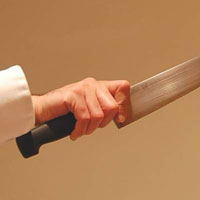Grip
The first mistake most new cooks make when using a knife is how to hold it properly.
When slicing and chopping the cook should use the pinch grip.
The pinch grip is where you pinch the spine of the knife between your thumb and pointer finger in front of the bolster. This helps you gain accuracy and control. And by moving the pivot point ahead of the bolster, you increase the power transfer from arm to blade.
Different Cuts
There are three main cuts in the kitchen.
The first is slicing. Cutting involves a long pulling stroke through the food. The deal blade for slicing is long and thin to reduce strokes and drag on blade. You can create many different cuts with slicing, like juleinne, brunoise and regular butterfly cuts.
The second is chopping. Chopping uses a forward cutting motion in which the entire length of the blade comes in contact with the board. Your hand moves in an orbital pattern. Your non-cutting hand should feed the food into your blade, which never moves and should act like a machine. When chopping, make sure to tuck your fingertips back so the blade would only come in contact with you knuckles. Chopping is useful for vegetables and herbs.
The last is paring. Paring is used to trim or reduce food in size. This is the only cut that takes place off of the cutting board. And the knife is always facing you. You use your thumb as a guide when peeling, which is scary at first, but with a sharp knife, you'll have no problem. You should never need to force a knife, that's when cutting is most dangerous.
